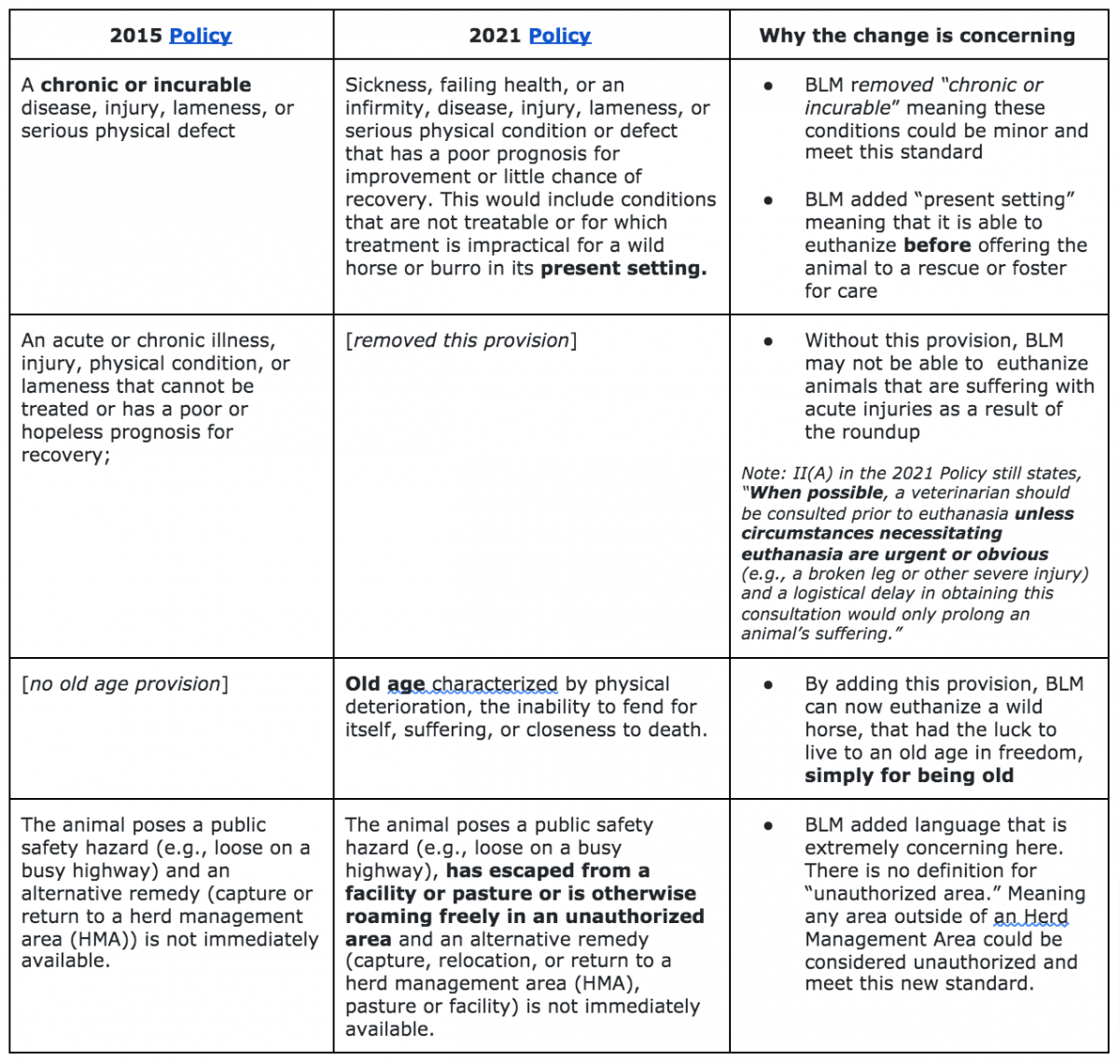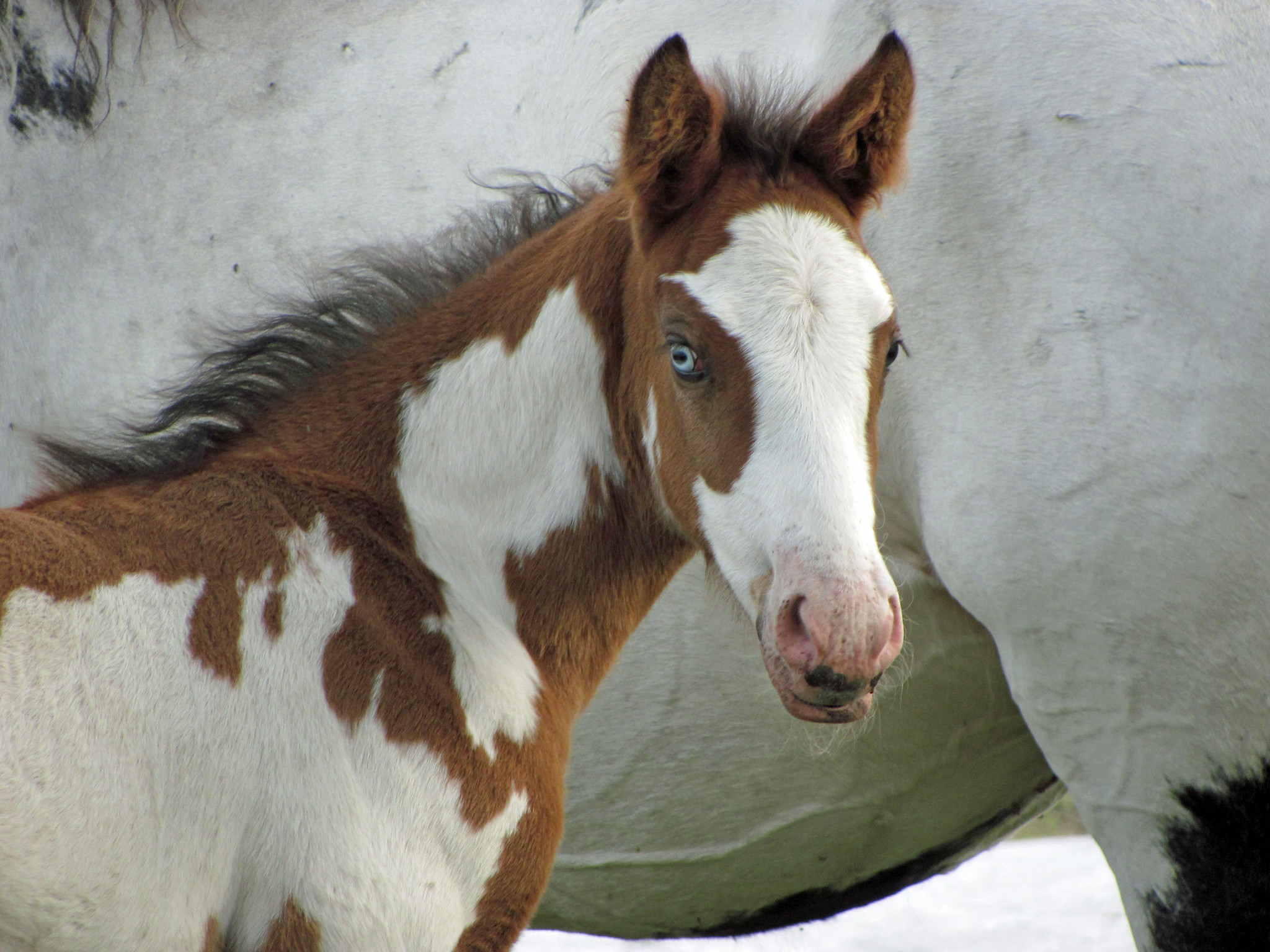(September 10, 2021) A new Bureau of Land Management (BLM) policy establishes protocols for the euthanasia of wild horses and burros. These policies are implemented immediately and without a chance for comment or input from the public. Worse still, policies are internal guidelines that influence the agency’s work internally and are not legally enforceable, unlike laws or regulations.
The new euthanasia policy, as implemented with Permanent Instruction Memorandum (PIM) 2021-007 dated May 2020 (but not publicly discovered until it was cited by BLM during the Sand Wash Basin Herd Management Area roundup on September 8, 2021) was revised in FY21 according to the BLM’s PIM.
According to the PIM, the new policy replaced a March 2015 Instruction Memorandum (IM) that established policy for much more than euthanasia alone. The 2015 IM covered “procedures for the proactive and preventative medical care of animals managed by the WH&B Program including deworming, vaccination, evaluation of animal condition and determination of an appropriate end-of-life action when indicated for reasons of an act of mercy, health or safety.”
Importantly, the 2021 PIM notes that the methods of euthanasia included are in line with the American Veterinary Medical Association (AVMA) Guidelines for the Euthanasia of Animals: 2020 Edition. Unlike the BLM’s policy, when mentioning how wildlife and free-roaming species should be euthanized, the AVMA continuously stresses how minimal handling is imperative. (Including how premedication of prey and non-domesticated species (wild horses and burros included) is strongly encouraged to reduce animal distress and improve personnel safety.) Instead, BLM allows for a captured horse to be standing on a trailer, confined in a small pen, portion of an alleyway, or in a chute. If a horse is agitated or will not stand calmly (as many wild animals won’t) BLM policy dictates the horse be placed in a chute and/or tied down for additional restraint.
The following is a comparison of the highlights of the two euthanasia policies.
“The Authorized Officer (AO) will euthanize or authorize the euthanasia of a wild horse or burro when any of the following conditions exist.”

The new policy also added some problematic guidance language:
- 2015 C(IV): Animals that are chronically affected with a body condition score of less than three will be euthanized within two weeks. Horses with a score of three will remain in the field and will be reevaluated by the contractor and the PI for that contract in 60 days to see if their condition is improving, staying the same or declining. Those that are declining in condition will be euthanized as soon as possible after the second evaluation.
- 2021 III(D): Animals with a body condition score of three, or less that do not appear to be acutely suffering or have a fair or better prognosis for improvement will be rechecked in 30 days. Those that remain below BC 3 will be euthanized within 72 hours of the second evaluation.
AWHC is concerned that even 60 days was not enough time between re-evaluations. According to our consulting equine veterinarian, 3-10 months is needed, with the first 10 days to two weeks being vital. Further, if horses in long-term holding facilities are in weakened states and consistently losing weight, the BLM should review the facility for inadequate care instead of blaming the condition of the horses on the horses imprisoned there.
- 2015 C(VI): Euthanasia at Adoptions or Public Events
- 2021 III(F) added: In the event that no qualified veterinarian is available within 2 hours, either on and/or off-site, and the need for euthanasia is obvious, the AO may load and transport the animal to a safe and discreet location and humanely euthanize it in order to prevent further Attachment 1-6 pain and suffering.
- The 2015 IM did not include captive bolt euthanasia.
- 2021 VI(3) added: Penetrating captive bolt shot to the brain of an animal that is humanely and adequately restrained (added with the updated guidance document from the AVMA).
The new policy also retained some problematic guidance language from the 2015 policy:
- III(B): During gather operations, the Contracting Officers Representative (COR), as delegated by the AO prior to the gather, will authorize the release or euthanasia of any wild horse or burro that they believe will not tolerate the handling stress associated with transportation, adoption/sales preparation, or holding. No wild horse or burro should be released or shipped to preparation or other facility with a preexisting condition that requires immediate euthanasia as an act of mercy.
- BLM is still allowed to euthanize a wild horse that the personnel believes will not tolerate handling or transportation. In other words, the agency can kill a wild animal on the most stressful day of its life because it does not want to be around humans, transported in a trailer for the first time ever, or shoved unnaturally into pens.
- III(C): Some conditions may not immediately be apparent during gathers or other points of origin, require additional assessment or evaluation over time, or may best be addressed after an animal is moved to an ORC or preparation facility.
- AWHC has proven through the Freedom of Information Act (FOIA) requests that the death rate from roundups only continues to rise after the horses arrive at holding facilities. This policy language allows BLM discretion to move horses to holding before euthanizing them in order to keep the reported onsite euthanasia/death rate lower.
- VI: As recognized by the AVMA, circumstances exist with free-roaming wild animals where capture and chemical or physical restraint may not be practical prior to euthanasia....Under these conditions and when an animal cannot be approached within a few feet, humane killing may be necessary to end the animal’s suffering as quickly and humanely as possible. In these instances, methods typically used when hunting big-game animals of North America (e.g., elk, moose) in an ethical and responsible manner will be employed. It is not appropriate in these instances to use smaller caliber (e.g., 5.56 mm) rifles or other weapons targeted at the brain from longer distances. High-powered rifles targeted at the heart/lung and shoulder areas of an animal standing still and at typical hunting distances will be used in this circumstance.
Finally, it is also concerning that this euthanasia-focused PIM is replacing an IM that covered so much more than euthanasia. Leaving the question of, what happens to the other policies?


